90 F. high in the Twin Cities Thursday.
83 F. average high on July 4.
101 F. high on July 4, 2012.
Dry today, if the sun is out for 3-5 hours we may hit 90F again this afternoon.
Jet Stream Odyssey
"I would be willing to pay a monthly fee for
this unbelievable weather" my friend Heidi texted me, in a state of
unmitigated weather bliss up on Pelican Lake. It's been a perfect week, a
well-timed example of how extraordinary Minnesota's skies can be by
mid-summer.
The same quirky weather holding pattern
responsible for record heat and wildfires out west and flooding rains
east of the mighty Mississippi, is keeping us dry and sun-sational.
And I'm not the only meteorologist baffled by
the configuration of the jet stream. Weather Underground's Jeff Masters
writes "This week's extreme jet stream pattern is the third time in the
past five weeks that we've seen a highly amplified ridge-trough pattern
that has led to extreme weather." From record heat in northern Canada
& Scandinavia to historic flooding in central Europe and Calgary,
these wild north-south swings in steering level winds are creating more
jaw-dropping extremes.
Dew points rise today, fueling a few T-storms by
the weekend, but highs reach the 80s; plenty warm for the lake or pool.
Better than average for a major holiday.
The older I get the less I take for granted. Like a picture-postcard-perfect 4th of July.
 Best Week of Summer?
Best Week of Summer? Who
knows - but the last 5-6 days have been...amazing. Finally, a streak of
spectacular Minnesota weather, and timing couldn't be much better. The
ECMWF keeps the immediate metro dry Friday and Saturday, a few T-storms
Sunday - Tuesday the wettest day as a weak frontal system arrives. If
the sun stays out much of today and Saturday 90F. isn't out of the
question.
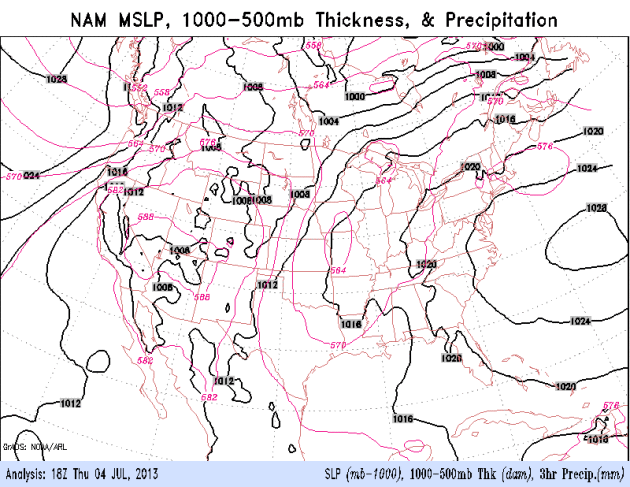 Gulf Coast Soaking
Gulf Coast Soaking.
The same fire-hose of moisture that drenched the Florida Panhandle,
Georgia, Alabama and much of the Mid South will drift west, dropping som
e2-4" rainfall amounts from Mobile, to New Orleans and Houston by
Sunday. The risk of showers and T-storms increases over the Upper
Midwest, while the eastern seaboard and west coast remains dry for the
next 84 hours. NAM
model data courtesy of NOAA.
2013 Half Year Weather Report Card. We're a little
more than halfway thru 2013; I thought this would be a good opportunity
to step back and take a larger look at trends so far this year. In
today's edition of
Climate Matters: "
We're
halfway through 2013. How does this year compare? WeatherNation Chief
Meteorologist Paul Douglas looks at temperature records,
precipitation, storm reports and much more. How has the first half of
2013 been for you in the weather department?"
Extreme Jet Stream Bringing U.S. Record Heat, Record Cold, And Flash Flooding. Here's an excerpt of a post from
Weather Underground
meteorologist Dr. Jeff Masters that quantifies how a high-amplitude
jet stream pattern, unusual for mid-summer, is wreaking havoc with
weather from coast to coast: "
The jet steam is exhibiting unusual behavior over the U.S.,
a pattern we've seen become increasingly common in summertime over the
past decade. There's a sharp trough of low pressure over the Central
U.S., and equally sharp ridges of high pressure over the Western U.S.
and East Coast. Since the jet acts as the boundary between cool,
Canadian air to the north and warm, subtropical air to the south, this
means that hot extremes are penetrating unusually far to the north under
the ridges of high pressure, and cold extremes are extending unusually
far to the south under the trough of low pressure. The ridge over the
Western U.S., though slowly weakening, is still exceptionally intense.
This ridge, which on Sunday brought Earth its highest temperatures in a
century (129°F or 54°C in Death Valley, California), was responsible
for more record-breaking heat on Tuesday. July 2. Most notably,
Redding, California hit 116°, just 2° short of their all-time record.
Death Valley had a low of 104°, the second hottest night on record
since 1920 (the hottest was just last summer!) Numerous daily high
temperature records were set in Arizona, California, Nevada, Utah,
Montana, Oregon, and Washington. It was the opposite story in the
Central U.S., where the southwards-plunging jet stream allowed record
cold air to invade Texas. Waco, Texas, hit 58°F this morning (July 3),
the coldest temperature ever measured in July in the city..."
Graphic credit above: "Jet
stream winds in the upper atmosphere at a pressure level of 300 mb on
July 3, 2013. The jet had an unusually extreme configuration for
summer, with a sharp trough of low pressure over the Central U.S., and
equally sharp ridges of high pressure over the Western U.S. and East
Coast." Image from the wunderground jet stream page."
What A Difference A Year Makes. A year ago today the
high was a blazing 101, with a wake-up temperature of 81. Ugh. On July
6, 2012 the high was 102. We enjoyed (?) 14 days at or above 90F
during July of last year, the hottest year in recorded Minnesota
history. Data above courtesy of
NOAA NCDC.
June Climate Highlights. Here's an excerpt from a
comprehensive summary of a very wet June, statewide, courtesy of Greg
Spoden at the Minnesota Climatology Working Group and the
Minnesota DNR: "June
totals were well above historical averages in most Minnesota counties,
except for far northern Minnesota where rainfall was somewhat below
average. In some communities, especially in southeast counties, monthly
precipitation totals topped the long-term average by more than 4".
* Persistently wet weather during June hampered many outdoor
activities. Field working conditions for agriculture were often poor.
Occurrences of rural and urban flooding were reported throughout the
month. Of particular note was an eight inch-plus rainfall reported in
northwest Wilkin County on June 25-26.
* Season-to-date precipitation totals top historical averages in most MInnesota counties.
April-through-June
precipitation totals in some southeast Minnesota counties were in
excess of 24", exceeding the historical average by an astounding 12 or
more inches.
* Just four percent of Minnesota's landscape is in Moderate Drought, a
substantial improvement over early April, when 67 percent of Minnesota
was experiencing Extreme or Severe drought.
* Stream discharge values are well above historical medians at many
gauging locations, and lake levels are responding upward to ample spring
and early summer precipitation.
As Arizona Fire Rages, Scientists Warn Of More Unpredictable Blazes. Here's a clip from a story at
The Los Angeles Times: "
Early
morning is a frenetic time at a wildfire command post. Biologists,
meteorologists, foresters and firefighters hustle into tents and grab
laptops to review overnight reports, prepping for the day's assault.
Fire behavior analysts run computer models that spit out information
crucial to putting out the blaze: how many acres a fire will probably
burn, in which direction and with what intensity. In recent years, the
models have been rendered practically obsolete, unable to project how
erratic Western fires have become, making tactical decisions more
difficult for fire bosses and the fire lines less safe for crews in the
field. The analytical work performed by fire scientists here at the
National Interagency Fire Center also confirms what seems anecdotally
evident: Wildfires are getting bigger — the average fire is now five
times as large as it was in the 1980s — and these enormous
conflagrations have a breathtaking facility to dance and grow.
Unforeseen winds are swerving and turning on fire crews, and it's no
longer unusual for fires to double in size in a day..."
Photo credit above: Los Angeles Times.
* weather conditions at the time of the Yarnell Hills blaze,
and what can be done, technologically, to get more current weather
information to the firefighters in the line of danger, from
Wildfire Today.
This Is America On Fire. Here's a clip from a good summary at
NationalJournal: "
As
of Tuesday, 1.8 million acres (an area the size of Delaware) in the
United States have been burned by wildfires this year—and about a half a
million of those acres are currently ablaze. Earlier this week, 19
elite firefighters died trying to contain a wildfire in Arizona.
Colorado experienced its most destructive fire of all time last month,
consuming more than 500 homes. But according to data from
the National Interagency Fire Center, 1.8 million acres is actually
typical for this time of year. The 10-year average for acres burned
between January and July is 2.4 million..."
Photo credit above: "
A fire eight miles northwest of Prescott, Ariz., blazes behind a row of houses June 24.
" ( USDA.gov)
Budget Cuts Trim Federal Wildfire Spending. Here's a clip of a story from AP and
ABC News: "
This
year's across-the-board budget cuts are slicing tens of millions of
dollars from the federal government's funds for battling wildfires,
reductions that have meant fewer firefighters and could cause agencies
to dip into other programs designed to prevent future blazes. The U.S.
Forest Service's $2 billion-a-year firefighting budget, which
comprises the bulk of the federal effort, has been reduced by 5
percent, a cut that has meant 500 fewer firefighters and 50 fewer fire
engines than last year, agency officials say. The Interior
Department's $37.5 million reduction has meant 100 fewer seasonal
firefighter positions and other lost jobs as well, department
officials say..."
Photo credit above: "
A wildfire burns homes in the Glenn Ilah area near Yarnell, Ariz., June 30, 2013."
(David Kadlubowski/The Arizona Republic/AP Photo)
There are currently 27
fires in the northeast section of Manitoba. These fires have burned
over 126,000 hectares (over 311,000 acres). Showers have lowered
wildfire danger levels in most areas of the province with the exception
of northeastern Manitoba where conditions continue to remain dry.
Read more at:
http://phys.org/news/2013-07-nasa-image-manitoba-canada.html#jCp
There are currently 27
fires in the northeast section of Manitoba. These fires have burned
over 126,000 hectares (over 311,000 acres). Showers have lowered
wildfire danger levels in most areas of the province with the exception
of northeastern Manitoba where conditions continue to remain dry.
Read more at:
http://phys.org/news/2013-07-nasa-image-manitoba-canada.html#j. This is Jerry
Seinfeld's new on-line project, in conjuntion with Sony Entertainment, a
series of video shorts with different comediens (and cars). Cool
concept, and great execution. It's funny too. Check out the web site
here.

TODAY: Warm sun, windy, a bit more humid. Dew point: 67. Winds: S 15-30. High: 88
FRIDAY NIGHT: Chance of a T-storm late, especially central/northern Minnesota. Low: 70
SATURDAY: Very warm and muggy. Scattered T-storms. Dew point: 70. High: 87
SUNDAY: Very sticky, a couple hours of T-storms. Dew point: 72. Wake-up: 72. High: 86
MONDAY: Sticky sun, isolated thunder. Wake-up: 73. High: 89
TUESDAY: T-storms likely, a few downpours. Wake-up: 71. High; 84
WEDNESDAY: Drier, cooler, less humid. Wake-up: 68. High: 83
THURSDAY: Warm sun, prime-time summertime. Wake-up: 66. High: 86
Climate Stories...
U.N. Charts "Unprecedented" Global Warming Since 2000. Here's an excerpt from
Bloomberg Businessweek: "
The
planet has warmed faster since the turn of the century than ever
recorded, almost doubling the pace of sea-level increase and causing a
20-fold jump in heat-related deaths, the United Nations said. The
decade through 2010 was the warmest for both hemispheres and for land
and sea, the UN’s World Meteorological Organization said today in an
e-mailed report examining climate trends for the beginning of the
millennium. Almost 94 percent of countries logged their warmest 10 years
on record, it said. “The decadal rate of increase between 1991-2000
and 2001-2010 was unprecedented,” WMO Secretary-General Michel Jarraud
said in a statement. “Rising concentrations of heat-trapping greenhouse
gases are changing our climate, with far-reaching implications for our
environment and our oceans...”
Look At This Chart And Then Try To Say Global Warming Doesn't Exist. Here's more on the latest WMO report, courtesy of
Quartz: "
The World Meteorological Organization just released its Global Climate Report
(pdf), which wastes no time in announcing a stark truth. The report’s
first sentence: “The first decade of the 21st century was the warmest
decade recorded since modern measurements began around 1850.” Nine out
of ten years between 2001 and 2010 were among the ten warmest in
recorded history, according to the report, and the warmest year to date
was 2010. For those worried about glacier melting, the heat spike
wasn’t isolated to land. The decade was warmest for both land and ocean
surface temperatures. In case anyone still doubts the existence of
global warming, take a gander at this chart."
Graphic credit
here.
Climate Change Is The Next $10 Trillion Opportunity. For the record, as an entrepreneur, I agree. But the train is leaving the station. Here's a portion of an Op-Ed at
Yahoo Finance: "...
President Obama made clear that he believes in our entrepreneurs, investors, and corporations who bringing climate change
solutions to market. What he did not do is inspire thousands more to
join them to unleash a climate wealth economy. These folks are all
motivated to do well by doing good. Our inspiration is not to just fix
climate change, it is to ignite the next economy by meeting our energy
needs using climate change solutions. Climate change is a trillion dollar opportunity masquerading a crisis. The next step for the president is to jump-start this next economy with the federal government
taking the lead. As much as I respect Europe and China, America is
still the last remaining superpower. Countries around the world are
looking not just for the moral message, but also for actions that drive
the global economy. An American president can powerfully lead the
world economy by dismissing the belief to solve climate change we must
all sacrifice. Rather he needs to spread the message that climate
change solutions represent the largest wealth creation opportunity of
our lifetime..."
At One Army Base, A Vision For A New Shade of Green. Here's an excerpt of an upbeat, empowering story about innovation in the military from the
Los Angeles Times: "...
If
a base is self-sufficient, it becomes less vulnerable to outside
threats, such as power outages, Pittard believes. And if the United
States and other countries husband their resources now, perhaps they
could avoid future wars. "Most of us have been deployed three, four,
five times," Pittard said. "If we do something like reduce our
dependence on oil from the Middle East, maybe we'd be fighting fewer
wars over there." The Pentagon says it has made overhauling energy use a priority. The U.S. military
is one of the world's largest consumers of fossil fuels, but by 2025,
it plans to draw at least 25% of its energy from renewable sources.
The Navy's fighter planes have begun to burn biofuel. The Pentagon is
experimenting with plug-in nontactical vehicles at several bases..."
Photo credit above: "
Maj. Gen. Dana J.H. Pittard, as commander of the Army's Ft. Bliss, pressed to set up environmental measures."
(Sgt. Valerie Lopez / September 10, 2010)
Business Journalists: Climate Change Deniers Have No Place In Our Reporting. What the heck is going on over at CNBC? Here's an excerpt from
Media Matters: "
Climate
change deniers should not be given a place in business coverage at a
time when industries from agriculture to insurance are making real
financial decisions dealing with its impact, according to some of the
nation's top business journalists. Last month Media Matters reported that
more than half of the climate change segments on CNBC this year cast
doubt on man-made climate change. That network's coverage drew
criticism from top business journalists who said
such coverage does not serve their viewers. "It doesn't seem to me at
this point to be a point of serious controversy within the corporate
establishment," said Paul Barrett a Bloomberg
BusinessWeek reporter (Bloomberg BusinessWeek's sister company
Bloomberg News is a CNBC competitor). "The insurance industry, which
is a key barometer of these things, has reached the conclusion that
whatever your politics are on this, the costs of extreme weather are
so great and the patterns over the last couple of decades are so
distinct that the corporate establishment absolutely must recognize
these risks..."
Has The Republican Party Stopped Denying Climate Science, And Will They Begin Participating In The Solutions? The Guardian has the story - here's the intro: "
Given that nearly 70 percent of Republicans in Congress and 90 percent of the party's congressional leadership deny the reality of human-caused global warming, you might expect them to attack President Obama's climate plan on scientific grounds. On the contrary, Republican politicians have critiqued President Obama's plan almost entirely on the economics.
Even Senator James Inhofe, who wrote an entire book based around the
absurd premise that "global warming is the greatest hoax ever
perpetrated on the American people," did not even touch upon climate
science when responding to the climate plan. This is a fascinating turn of events. Perhaps Republican politicians have decided that disputing the consensus of 97% of climate research and climate experts
is a losing proposition. Whatever the reason, the shift away from
science denial toward the economics debate is a welcome one. As even
the right-wing Washington Times admitted,
remaining entrenched in climate science denial has prevented the
Republican Party from becoming involved in discussions about the best
way to reduce greenhouse gas emissions with the least impact on the
economy..."
Cartoon above courtesy of
Tom Toles, at The Washington Post.
Church Dropping Fossil Fuel Investments. Here's a clip from
The New York Times: "
The
United Church of Christ has become the first American religious body
to vote to divest its pension funds and investments from fossil fuel
companies because of climate change
concerns. The Protestant denomination, which traces its origins to
the Pilgrims in 1620 and has about 1.1 million members, voted on
Monday to divest in stages over the next five years..."
Was Paul Revere An Alarmist? Here's a tongue in cheek, but devastatingly effective Op-Ed from
Huffington Post: "
On
this Independence Day, it is worth reflecting on the willingness of
our founding fathers to sacrifice their own comforts for the
future--for many generations to come, including ours. They didn't argue
about discount rates, or how expensive it would be, or if fighting the
British would be cost effective in the long run. Imagine what would
have happened if the "skeptics" had been given equal time, or if the
patriots had lacked the will to "mitigate the threat".
"The weight of evidence suggests that it is 'very
likely' (probability greater than 90%) that the British are coming. I
am not advocating any specific mitigation or adaptation response."
(Paul Revere, if he had been a climate scientist)
"We
should refrain from asserting that the British are (or are not)
coming without IMMEDIATELY pointing out that such theories are based
upon information that critics have called into question. It is not our
place as journalists to assert such notions as facts." (Fox News, if
cable TV had existed in 1775)..."
This Is What Climate Change Looks Like: Top 10 Most Expensive Climate Disasters of 2012. Here's a story from
Huffington Post
that provides some perspective, more examples of how a warmer, wetter
climate is fueling more extreme storms - and consequences: "
On Tuesday President Obama released his climate action plan
-- and not a moment too soon. Extreme weather has been pounding the
U.S., and while pundits and the fossil fuel industry will claim
action is too expensive, the cost of inaction is far too much to
bear. In 2012 there were 11 climate disasters that cost more than $1
billion each, according to NOAA. Below are the 10 most expensive.
1. Hurricane Sandy - cost $65.7 billion and caused 159 deaths
Hurricane Sandy touched down on U.S. soil on October 29 after
leaving a path of destruction through Jamaica, Haiti, the Dominican
Republic, Cuba, the Bahamas, and Bermuda. Sandy was the
second-costliest and deadliest hurricane ever to hit the U.S. after
Hurricane Katrina in 2005. A total of 24 states were affected, with
thousands of homes destroyed and millions of people left without
electricity. Of the direct deaths, the storm caused 48 direct deaths
and 87 additional indirect deaths."
Photo credit upper left:
EPA/MASTER SGT. MARK OLSEN / US AIR FORCE
Photo credit upper right:
NWS Meteorologist Samuel Shea
A Decade Of Weather Extremes.
Here
is a PDF of a Cournou-Rahmstorf paper published in March, 2012 that
sums up weather and climate extremes during the first decade of the 21st
century.
2001-2010: A Decade of Climate Extremes. Here is more from the WMO, the
World Meteorological Organization: "...
The
decade was the warmest for both hemispheres and for both land and
ocean surface temperatures. The record warmth was accompanied by a rapid
decline in Arctic sea ice, and accelerating loss of net mass from the
Greenland and Antarctic ice sheets and from the world’s glaciers. As a
result of this widespread melting and the thermal expansion of sea
water, global mean sea levels rose about 3 millimetres (mm) per year,
about double the observed 20th century trend of 1.6 mm per year. Global
sea level averaged over the decade was about 20 cm higher than that of
1880, according to the report...."
*
The BBC has more details on the record number of climate extremes during the first decade of the 21st century.



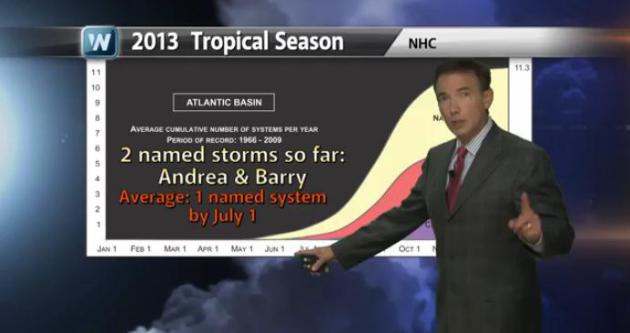



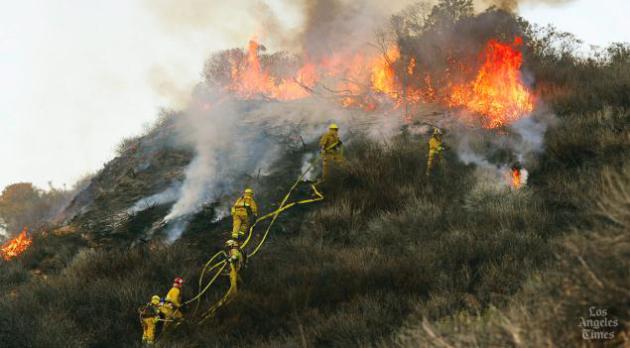
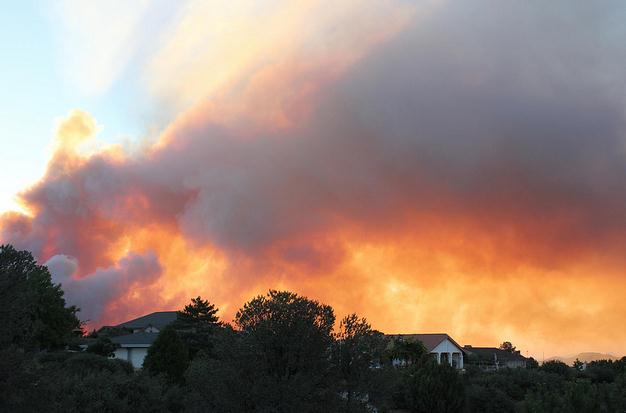
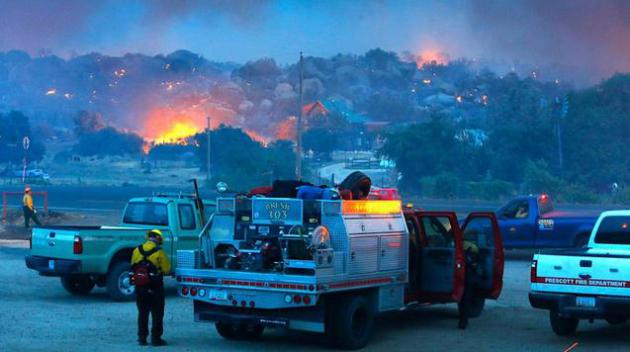



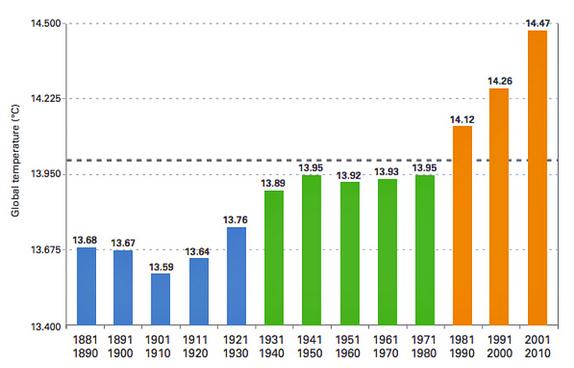
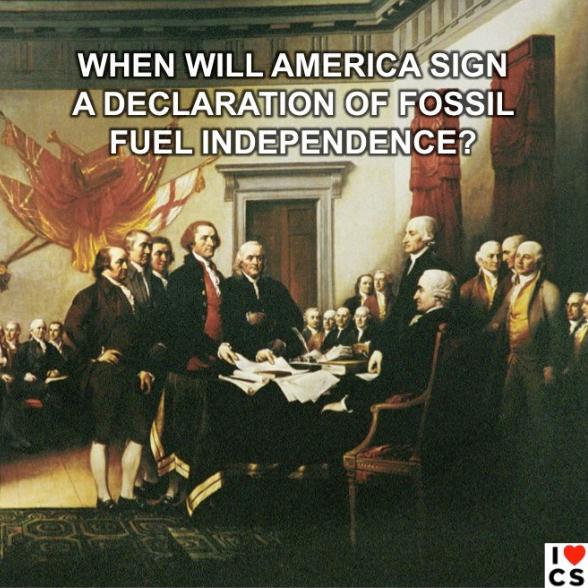


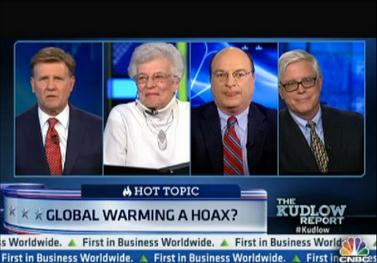
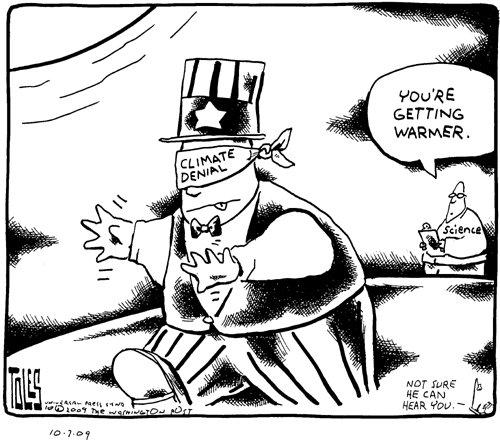


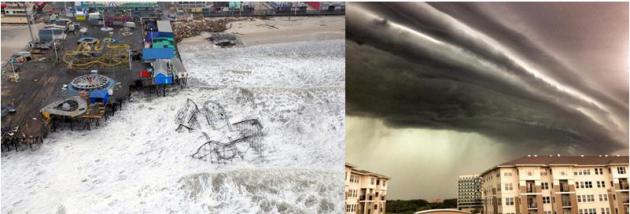
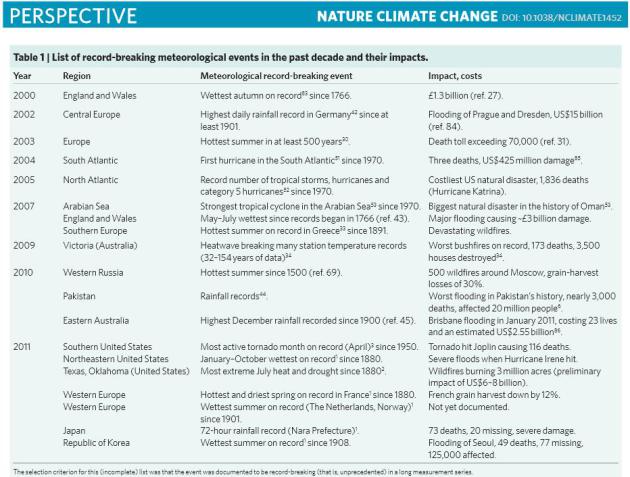
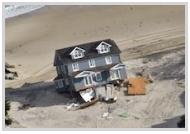
No comments:
Post a Comment